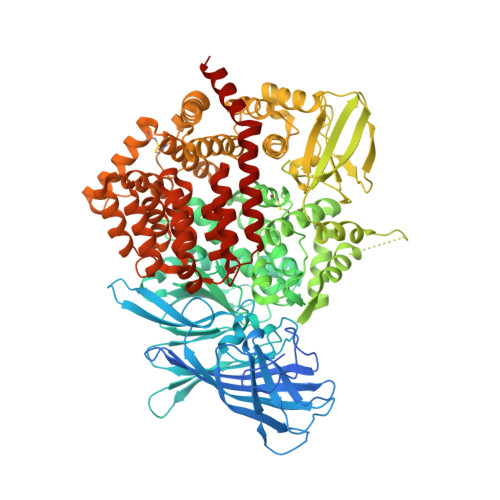Rationally designed inhibitor targeting antigen-trimming aminopeptidases enhances antigen presentation and cytotoxic T-cell responses.
Zervoudi, E., Saridakis, E., Birtley, J.R., Seregin, S.S., Reeves, E., Kokkala, P., Aldhamen, Y.A., Amalfitano, A., Mavridis, I.M., James, E., Georgiadis, D., Stratikos, E.(2013) Proc Natl Acad Sci U S A 110: 19890-19895
- PubMed: 24248368
- DOI: https://doi.org/10.1073/pnas.1309781110
- Primary Citation of Related Structures:
4JBS - PubMed Abstract:
Intracellular aminopeptidases endoplasmic reticulum aminopeptidases 1 and 2 (ERAP1 and ERAP2), and as well as insulin-regulated aminopeptidase (IRAP) process antigenic epitope precursors for loading onto MHC class I molecules and regulate the adaptive immune response. Their activity greatly affects the antigenic peptide repertoire presented to cytotoxic T lymphocytes and as a result can regulate cytotoxic cellular responses contributing to autoimmunity or immune evasion by viruses and cancer cells. Therefore, pharmacological regulation of their activity is a promising avenue for modulating the adaptive immune response with possible applications in controlling autoimmunity, in boosting immune responses to pathogens, and in cancer immunotherapy. In this study we exploited recent structural and biochemical analysis of ERAP1 and ERAP2 to design and develop phosphinic pseudopeptide transition state analogs that can inhibit this family of enzymes with nM affinity. X-ray crystallographic analysis of one such inhibitor in complex with ERAP2 validated our design, revealing a canonical mode of binding in the active site of the enzyme, and highlighted the importance of the S2' pocket for achieving inhibitor potency. Antigen processing and presentation assays in HeLa and murine colon carcinoma (CT26) cells showed that these inhibitors induce increased cell-surface antigen presentation of transfected and endogenous antigens and enhance cytotoxic T-cell responses, indicating that these enzymes primarily destroy epitopes in those systems. This class of inhibitors constitutes a promising tool for controlling the cellular adaptive immune response in humans by modulating the antigen processing and presentation pathway.
Organizational Affiliation:
National Center for Scientific Research Demokritos, Agia Paraskevi 15310, Greece.




















